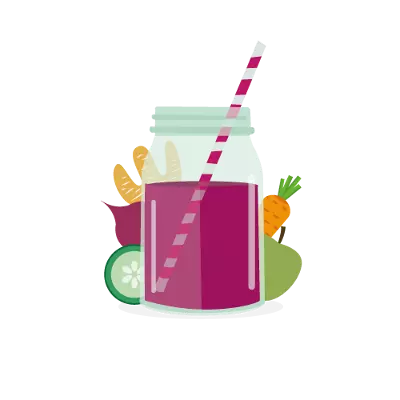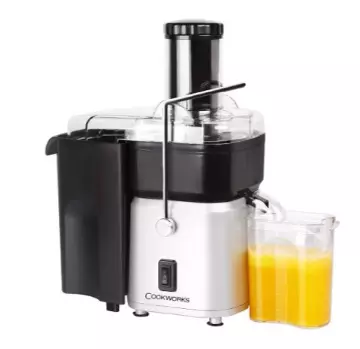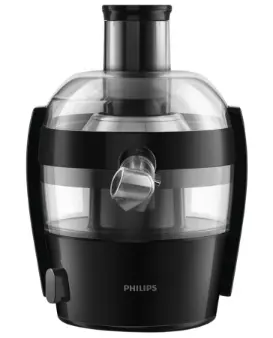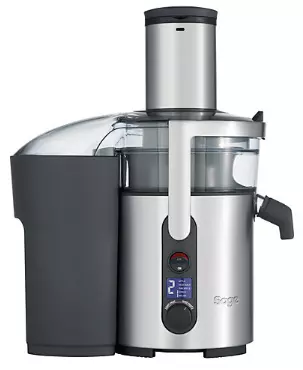
The term juicing refers to combining fruits and/or vegetables in a juicer, breaking them down to liquid form, resulting in - hopefully - a delicious and healthy juice drink to enjoy.
We all know that vegetables and fruit are a brilliant way of adding essential vitamins and minerals into our diet, but juicing is the perfect way to stock up on even more. What’s more, as the vegetables and fruit used in juicing are raw, you might be bagging more benefits when it comes to these essential vitamins.
A recent study has found that eating 5 a day may not be enough when it comes to fruit and veg intake, but trying to fit more into your diet can seem like an uphill battle. For most of us, it can be a struggle to even fit the recommended 5 into our diets, let alone more. Juicing is a way of reaching that number quite easily, without having to spend your waking hours chowing down on greens.
A Beginner's Guide to Juicing
This guide will take you through why you should juice, what sort of things you should be juicing and the common misconceptions of juicing. Plus we'll give you some delicious recipes to try to help you kick start a juicing lifestyle.
Juicing can be a great way to add some brilliant nutrients and antioxidants into your health. However, be warned, juices should be part of a healthy diet change and not a quick fix to weight loss.
- Who is Juicing Good For?
- Why Juice?
- Common Misconceptions of Juicing
- Top Health Benefits of Juicing
- Antioxidants and Free Radicals
- Best Fruit and Vegetables for...
- Celebs' Favourite Juices
- 30 Day Juicing Challenge
- A-Z Produce Preparation
- Substitution List
- Juicer vs Blender
- Expert Advice and Tips
Who Is Juicing Good For?

Practically everyone! If you are looking to improve your nutrient intake then it's time to get juicing!
Certain people do have to be careful when it comes to adding fruit based juices into their diet such as borderline diabetics, those suffering from candidiasis or prone to thrush. If this is you then it's best to check with your doctor before adding extra sugar into your diet. Vegetable based juices should, however, be fine for you.
Professor Joe Millward, Director of the Center for Nutrition and Food Safety at the University of Surrey, explains the benefit of consuming vegetables and fruits in their raw state, “Some vitamins are damaged by cooking so eating them raw really is the best way to get them. Interestingly, even the most complete supplement mix cannot begin to match the nutritional complexity of a fresh fruit and veg juice”.
So, if you are looking to optimise your health, boost athletic performance and add more fruit and veg into your diet; juicing is certainly the thing for you.
Why Juice?
Juicing helps you to add more nutrients, vitamins, and antioxidants into your diet - mixing up juices can  help you to consume a variety of veggies and fruit that you may not eat normally.
help you to consume a variety of veggies and fruit that you may not eat normally.
The process of juicing extracts insoluble fiber from fruits and veg. This means juicing is easy on the digestive track and nutrients are well absorbed by your stomach.
Avid juicers report glowing skin and greater energy and with the addition of all that extra fruit and veg in your life - it seems likely!
Juicing allows you to consume a healthier amount of vegetables in an efficient manner
Having a juice in addition to your normal diet, or in replacement of a meal - such a carb heavy breakfast - can help you to hit your fruit and veg target easily, flooding your body with essential nutrients and antioxidants. Even cooking vegetables can destroy some of the great enzymes in fruit and veg, but when juicing the raw ingredients they remain!
Juicing helps you to absorb immune boosting nutrients
When you break down vegetables and fruits to a juice you remove the insoluble fiber. Removing the indigestible insoluble fiber means that the nutrients within the fruit and veg are available to the body in much larger quantities than if the piece of fruit or vegetable was eaten whole.
For example, juicing makes the most of the humble carrot’s beta-carotene benefits. As most of the nutrients are trapped in the fiber of the carrot when eating you are only able to assimilate about 1% of the available beta-carotene. When juiced, removing the fiber, you can assimilate nearly 100% of the beta-carotene.
Juicing helps us to adopt healthier eating habits
Incorporating a variety of vegetables and fruits into your diet that you may not normally consume. Juicing can be a kick start to a healthier eating pattern, potentially changing your mindset and taste buds in the process!
Juicing can be an aid to weight loss
Vegetables are both low in fat and full of vitamins and minerals. Kick-starting a healthier way of life through juicing may also add the additional side effect of helping you to lose weight. Sticking to mainly vegetable based juices also ensures that you aren’t consuming loads of extra calories that may come from fruit juicing.
Juicing is good for our digestive track
Much is discussed around juicing such as it’s aid to digestion and it’s cleansing benefits. Recent studies have found that claims that juices cleanse are unfounded as your body is constantly ridding itself of toxins.
However, whilst your body is designed to remove toxins on its own through the liver, kidneys, and colon this doesn't mean that juicing isn't a positive thing for your digestive track. As juices require less processing from the stomach - acid, churning and pepsin - it allows the stomach to rest whilst extracting all those beneficial nutrients.
Juicing helps to improve energy
Drinking a healthy, organic vegetable based juice from home will give you a big boost of amazing antioxidants and nutrients helping to enhance your energy
Juicing helps to keep you hydrated
How many of you stick to the eight glasses of liquid a day? Drinking a small glass of juice counts as one of these. Have one of these in the morning and it’s one glass of liquid already checked off the list.
Common Misconceptions about Juicing
Is juicing good or bad for you? When it comes to the topic of juicing there is plenty of debate. Even from within the group of pro-juicers there can be opposing opinions around what type of juicing is best. These differing opinions can lead to understandable confusion about the pros and cons when it comes to juicing.
Here, we try to break down the different misconceptions that are out there to give you a full picture of how juicing can be beneficial to you.
Juices are bad for you
Juicing is not bad for you if you consider what you are juicing and how you are taking your juices. As part of a well-rounded, nutrient-dense diet juicing can be very beneficial. You must also take careful consideration over what juices you make; using high sugar fruits such as pineapple, grapes and mangoes may taste delicious but using more veg in your juice will be way more beneficial. Green vegetables, in particular, are some of the best for you.
Smoothies are better than juices
Although smoothies are a fantastic way of getting fruit and veg into your diet, a smoothie will typically contain other ingredients such as dairy products, protein powders, and oats plus sweeteners such as honey and syrups, for example. Although many of these things are not inherently bad for you, smoothies can often contain additional calories that you may not be aware of.
You’ll be missing out on fiber
Typically juices are made from only fruit and vegetables that are liquefied. So when it comes to juicing, there is much discussion about removing the fiber from the fruit and veg. Juicing removes most of the insoluble fiber from the fruit and veg, however, the soluble fiber remains. Fiber is very important for our bodies and as long as you are keeping your fiber up in the rest of your diet, juicing is still a fantastic way to add more nutrients.
Buying a store-bought juice is better than no juice
When buying bottled juices you need to consider what kind of juice you are buying. A lot of store-bought juices may contain little to no nutrients or enzymes, thus making them not beneficial to the drinker. Juices that are able to remain in a store on the shelf for months, essentially, have very little to offer in the way of nutrients but give you an insulin spike due to the fructose sugar content - and potentially added sugar - which can be doing more harm than good.
Instead, if buying from a store, you need to be on the lookout for organic, raw and cold-pressed juices that are mainly veg based with a few fruits thrown in for taste. Although you may initially not be used to this less sugary drink, however, you will reap the benefits of loads of antioxidants without that huge insulin spike.
Any veg is better than no veg
Yes, of course consuming fruit and vegetables is good for you, however, organic really is best. Using non-organic vegetables and fruits means that you will be ingesting pesticides and antibiotic-resistant bacteria. Juicing organic fruit and veg means you will be drinking these foods in their natural state.
Eating fruit and veg whole is better for you
In a word, yes. However, that doesn’t make juicing a bad thing. Although food is best consumed in its whole-food state, juicing can be a great addition to any diet. Drinking raw juices can help you increase your antioxidant and nutrient intake alongside a nutrient dense diet.
You can replace meals with juices
One of the biggest misconceptions surrounding juicing is that you are able to substitute most of your main meals with juices in a healthy way in the form of a 'juice diet' or 'juice cleanse'. Although juices are full to the brim with great antioxidants and other nutrients, replacing a meal your meals with them is not recommended. Purely consuming juices means that you are restricting your diet from major nutrients; protein, fats and adequate fiber are not available from juicing alone.
Replacing one meal a day, such as breakfast, won’t necessarily cause harm as long as you make sure that your diet has all the essential nutrients including enough protein and fats.
Juicing is a quick way to lose weight
Yes juices can help you to lose weight, however juicing over a longer term can not only have a negative impact - such as when used as a meal placement - due to their lack essential nutrients as fats and protein, but it can also be really hard to sustain. A juice diet which restricts your diet to a very low-calorie count - such as 800 calories or less - can actually do the opposite of helping you to lose weight. Restricting your diet in this way will lower your metabolism, resulting in difficulties in losing weight long term.
What juicing can do is help you to change your habits and make you more mindful of the food you are eating and/or how often you are snacking. It may have you reaching for another piece of fruit mid-morning rather than a high sugar snack. In order to lose weight by juicing, it has to be part of a wider change to your diet.
Top Health Benefits of Juicing
Antioxidants and Free Radicals
Free radicals are highly reactive chemicals that have the potential to harm cells, these are formed naturally in the body and play a role in the many of the body’s normal cellular processes. Lots of free radicals in the body can, however, can be hazardous to the body.
Antioxidants are amazing chemicals that can interact with free radicals and neutralize them combatting any damage they may cause. Although our bodies create some of the antioxidants needed to combat free radicals it also needs external sources of antioxidants, primarily sought from our diets.
Vitamins A, C and E, as well as beta-carotene and lycopene, are all dietary antioxidants that can be found in fruits and vegetables. Juicing is a fantastic way of getting the necessary amount of antioxidants that our bodies need.
Most of us don’t reach out recommended daily amount of vitamins, in the US around 90% aren’t getting enough vitamin E and around 15% are vitamin C deficient. If you too aren’t quite hitting your recommended daily intake, this kind of deficiency is easily rectifiable by boosting your intake of vegetables and fruits that are full of these vitamins.
Vegetables and Fruits to improve...
Hair and Nails
Vitamins A, B, C, E, K can all be found in leafy green vegetables as well as iron which can help combat brittle hair and nails. Our diet often can manifest itself in unhealthy looking skin, hair, and nails and so adding in a good dose nutrients through juicing can really help you make you look your best.
Green vegetables such as Kale and Spinach are perfect for getting all these great nutrients plus calcium, magnesium, and potassium - minerals which are vital to the health of your nails and hair.
Energy
Iron, found in Kale and Spinach, is a key component of energy production in our bodies. Popeye has long known this, but take a (green) leaf out of his book and add a good portion of leafy greens to your juice to give you a wonderful energy boost.
Skin
Collagen makes our skin appear plump and smooth, so adding in some collagen boosting fruits and veg via juicing is a great way to keep the wrinkles at bay whilst giving you an overall radiant complexion.
Vitamin C is a key player when it comes to boosting your collagen levels, it’s a great antioxidant that slows down the rate of damage caused by free-radicals. Try adding in some of these fruits and veg which are high in the big C: oranges, kiwis, raspberries, green leafy vegetables, and tomatoes.
Vitamin A, found in carrots, also helps to slow the breakdown of collagen and elastin which causes ageing.
Bloating
Ginger has been found to really help when it comes to bloating. Compounds in ginger get your gastric juices flowing which gives a boost to your digestive system. Add a little bit to your juice to give it a zing whilst helping to flatten your tum!
Brain Functionality
Studies have found that beetroots contain nitrate which lowers blood pressure and helps fight heart disease. Not only do nitrates offer these wonderful benefits, they have also been linked to increasing blood flow to the brain so may be good for overall brain health.
Bones and Teeth
Most of us get our calcium from dairy products and nuts but did you know you can also improve your calcium intake with calcium-rich vegetables which include dark leafy greens like kale and spinach, broccoli and celery.
Throw a handful of leafy greens into your juicer to up your calcium intake today!
Eyesight
Carrots help you see in the dark? Well, not quite, however, they can certainly help give you your fill of vitamin A which helps with eyesight. Carrot juice contains over 400% of your daily intake of vitamin A. Vitamin A is also great for muscle healing so a carrot juice is perfect for a post workout beverage.
Other big hitters in the Vitamin A game are cucumbers, citrus fruits, dark leafy greens, tomatoes, and berries.
Liver Function
Although lemons may seem quite acidic, they are actually very alkali - perfect for giving your liver a cleanse - add a squeeze of lemon to your juice to help you wake up your liver and flush nasty toxins out.
Celebs' Favourite Juicing Recipes
If you are keen to get juicing, there is no need to run out and purchase a juicing recipe book! Below, we have collated a selection of juices - favoured by the stars - to get you started. From juices that will energize you in the morning to those give you a little boost in the afternoon, these juices will help make you feel good from the inside out - plus they taste pretty great too!
Most of these juices are vegetable based, which is what you want to be having on a daily basis. Fruit based juices are OK to have every now and then but be careful as these are quite high in sugar, so make sure you have these types of juices as a treat.
Note: All juices make one serving.
Gwenyth Paltrow's Green Juice
 Are you someone who wakes up and immediately reaches for a cup of coffee? This is the perfect start to your day to give you energy without giving you the post morning caffeine crash.
Are you someone who wakes up and immediately reaches for a cup of coffee? This is the perfect start to your day to give you energy without giving you the post morning caffeine crash.
Both healthy and invigorating, this juice contains plenty of calcium and antioxidants from the leafy green super veg that is Kale. The kale becomes vibrant when juiced with the lemon, apple, ginger and mint; giving you a lemony twang.
You will need:
5 large leaves of kale roughly chopped
1 lemon, zest and pith removed
1 large apple, roughly chopped
A 2.5cm piece of fresh ginger
1 sprig of fresh mint
Method:
Push all the ingredients through your juicer. Alternatively, you can chop all the ingredients and pop them into a powerful blender with 120ml of water, then pass the mixture through a fine-mesh strainer and drink immediately.
Juice recipe can be found here by Gwenyth Paltrow.
Deliciously Ella's Beetroot, Cucumber and Ginger Juice
 Another great juice to get you going in the morning! This is quite sweet-tasting, so a good one to wean you onto juices.
Another great juice to get you going in the morning! This is quite sweet-tasting, so a good one to wean you onto juices.
You will need:
1 beetroot
1 cucumber
2 sticks of celery
3 carrots
1 red apple
an inch of ginger
Method:
The only preparation you need to do is to chop the leaves off the beetroot and peel away the outer layer of dirt and thicker skin, then chop the leaves off the celery. Once this is done simply put everything through the juicer, stir, sip and enjoy!
Find Deliciously Ella's recipe here.
Nicole Richie's Carrot-Beet Juice
Need a bit of a boost? This zingy juice will give you a sweet little kick!
You will need:
2 medium carrots, washed well and peeled
1/2 apple
1/4 beet
1 1-inch piece of fresh ginger root
Method:
Add ingredients in above order to juicer. Blend until smooth and serve immediately
Juice recipe can be found here.
Deliciously Ella's Very Berry Juice
 This is a deliciously fruity juice drink, but one to be taken in moderation as it does have quite a high sugar content.
This is a deliciously fruity juice drink, but one to be taken in moderation as it does have quite a high sugar content.
You will need:
2 apples
1 cucumber
1 handful of blueberries
1 handful of strawberries
1 handful of raspberries
1 handful of blackberries
Method:
Prepare all your ingredients and push through your juicer. A wonderful, bright and fruity juice will appear - enjoy!
Recipe available at Deliciously Ella.
Gwenyth Paltrow's Cucumber, Basil and Lime Juice
This juice has a bit of a mojito vibe - try blending with a few cubes of ice to make it really refreshing!
You will need:
1 handful of basil leaves
1 cucumber, cut in half lengthwise
½ lime,zest and pith removed
1 apple, cut into wedges
Method:
Starting with the basil, juice everything into a glass. Alternatively, you can chop all the ingredients and pop them into a powerful blender with 120ml of water, then pass the mixture through a fine-mesh strainer into a glass. Give it a stir and drink immediately
Recipe by Gweneth Paltrow
Michelle Williams' Green Goodness Juice
 Our second pick of the green juices. This one has a few more greens in it, so wait until you have acclimatised through the other juices before giving this one a try.
Our second pick of the green juices. This one has a few more greens in it, so wait until you have acclimatised through the other juices before giving this one a try.
You will need:
3 kale leaves
1 cup spinach
2 Swiss chard leaves
4 apples (use green for less sugar)
1/2 lemon, peeled
Method:
Combine all ingredients in a juicer and process until you have a deliciously green juice.
30 Day Juicing Challenge

There is a lot of buzz around juicing, 'juicing cleanses’ and 'juicing detoxes'. According to many health professionals, a juicing cleanse - which consists of only drinking juice for meals - should be avoided. In order to get the very best out of juicing, you should try to see juicing as a supplement rather than a diet.
Not only is a juice only diet hard to maintain, you will be embarking on a calorie deficient diet which in the long run is not good for your health.
If you want to get into juicing, a 30-day challenge is a great way to kick start your juicing lifestyle. By either adding a juice to your morning routine or if you really wish to switch out a meal, breakfast would be the best option.
Juicing on an empty stomach is best as your body is able to absorb all the nutrients so the perfect time to drink is before breakfast. If you do wish to wait until later in the day, wait for at least two hours after you have eaten.
Why not embark on a 30 Day juicing challenge? Try drinking one juice every day for 30 days. Hopefully, this can help retrain your eating habits, helping you make healthier choices during your day.
A-Z Produce Preparation
There are so many possibilities when it comes to creating juices, just take a look below at the number of fruit and vegetables that can be juiced.
When making your juices, you want to make sure you are preparing - and including - all the good stuff, so we have outlined this in the below table. Further down, we have also given you a few herbs and spices that can give your juice that real zing! When picking up your ingredients, check out vouchercloud discounts for the likes of Tesco, Sainsbury's, Ocado and Morrisons.
| Fruit / Vegetable | Preparation |
|---|---|
|
Apples |
Core and remove the seeds prior to putting through your juicer. |
|
Apricots |
Rinse, slice in half and then remove the stone. |
|
Avocado |
Avocados are fine to be used in a blender - but do not put through a juicer (they cannot be juiced!) |
|
Bananas |
Similar to avocados, Bananas are great added into a blender to thicken up your juice but don’t put through a juicer as they cannot be juiced! |
|
Beetroot |
You can juice both the beet and its greens. Remove the skin to avoid the earthy taste which can be off-putting and chop into smaller pieces to fit in your juicer. |
|
Blackberries |
Rinse just before juicing. |
|
Blueberries |
Rinse just before juicing. |
|
Broccoli |
Rinse then juice the whole broccoli - stalks and all! |
|
Cabbage |
Both green and red cabbages are good for juicing. Just rinse and cut into smaller pieces to fit into your juicer. |
|
Cantaloupe Melon |
Cut into smaller pieces to fit in your juicer, removing the rind, flesh and seeds. |
|
Carrots |
Rise thoroughly before juicing. You can juice the skin and greens of a carrot too! |
|
Celeriac |
Make sure to wash thoroughly. Or, like with beetroot, you can remove the skin which gives a less earthy taste. Cut into smaller cubes to fit into your juicer. |
|
Celery |
Rinse thoroughly and juice the entire stalk including any leaves. |
|
Chard |
Rise all leaves individually. Often dirt can hide quite well so make sure you are thorough. Keep the stems, roll up and push through your juicer. |
|
Cherries |
Rinse and use a small knife to remove the stones before putting in your juicer. |
|
Courgettes |
Scrub the skin and rinse. Cut off the stem and push through your juicer. |
|
Cranberries |
These are very tart so best juice with sweet fruit and veg. Rinse and just put through your juicer. |
|
Cucumbers |
Wash and cut in half. Push through your juicer. |
|
Dandelion |
Wash and roll up to push through your juicer. Use harder vegetables/fruit to get it through. |
|
Fennel Bulbs |
Rinse and cut, then push straight through your blender. Has a slight aniseed/licorice taste - so not one for you non-licorice lovers out there! |
|
Grapefruit |
Peel, but try to keep as much pith on the fruit as possible. The pith contains loads of nutrients that will help you absorb all the good stuff. Cut up and put through your juicer - keep the pips as these are good for you too! |
|
Grapes |
Remove from the stem and give your grapes a rinse then simply put through your juicer. All colour grapes are good for juicing! |
|
Kale |
Like chard, dirt can hide in the kale leaves so make sure you wash thoroughly before pushing through your juicer. |
|
Kiwi |
Peel and run the fruit through your juicer. |
|
Leeks |
Cut in half lengthways, keeping the root on. Wash thoroughly to remove and dirt that may be hiding in between the layers. |
|
Lemons |
Same as other citrus fruits, peel and try to keep as much of the pith on. Juice the whole of the lemon with the seeds as these are full of loads of good nutrients too. |
|
Limes |
Same as other citrus fruits, peel and try to keep as much of the pith on. Juice the whole of the lime, with the seeds, as these are full of loads of good nutrients too. |
|
Mangoes |
Peel and cut pieces of mango flesh from the core then push through the juicer. |
|
Melons |
Remove seeds and skin then cut into pieces and push through your juicer. |
|
Onions |
Onions are pretty strong so go easy when juicing these so as you might imagine, they aren’t for everyone. Peel away the papery skin and slice into smaller pieces. Add a little bit at a time to get the desired taste. |
|
Oranges |
Same as other citrus fruits, peel and try to keep as much of the pith on. Juice the whole of the orange with the seeds as these are full of loads of good nutrients too. |
|
Papayas |
Peel the skin off, cut in half then juice including the seeds. |
|
Parsnips |
Give them a scrub and then push through your juicer. Cut in half lengthways if need be |
|
Peaches |
Wash, cut in half and then remove the stone. |
|
Pears |
Wash, remove the stalk and cut into pieces. |
|
Peppers |
Rinse and remove the stem. Seeds can be juiced so just cut into smaller pieces and put through your juicer. |
|
Pineapples |
Cut off the top of the pineapple. Slice into quarters, removing the skin and the hard woody core then juice. |
|
Plums |
Wash, slice into half and remove the stone. |
|
Pomegranate |
Cut in half and, using a wooden spoon, hit back of the pomegranate over a bowl to collect all the seeds. Juice the seeds. |
|
Radishes |
Give radishes a rinse and Remove any leaves but push through with root and stem on no problem. Add these one at a time as they are quite spicy! |
|
Raspberries |
Just rinse and juice. |
|
Romaine Lettuce (Cos Lettuce) |
Rinse individual leaves as dirt can get stuck between them. Roll up and push through your juicer. Follow with harder veg or fruit to push them all the way through. |
|
Spinach |
Wash well to remove any dirt or grit. Roll up and push through your juicer. Follow with hard fruit or veg to push the leaves through. |
|
Squashes |
All squashes can be washed chopped and pushed through the blender, seeds included. If the skin is a little hard you can remove and push the rest through. |
|
Strawberries |
Rinse and put through your juicer. Can be quite sweet. |
|
Sugar Snap Peas |
Although not much water content in them still worth juicing if you have some in your fridge. Just rinse and juice. |
|
Sweet Potatoes |
Scrub and cut into smaller pieces and pop right into your juicer. |
|
Tangerines |
Same as other citrus fruits, peel and try to keep as much of the pith on. Juice the whole of the tangerines with the seeds as these are full of loads of good nutrients too. |
|
Tomatoes |
Wash, remove stem and leaves then pop into your juicer. Chop smaller if you need to, but no need to remove the seeds. |
|
Turnips |
Scrub then chop into chunks to fit your juicer. |
|
Watermelon |
Cut into wedges then remove the skin and rind. You can keep the seeds in, then juice. |
|
Wheatgrass |
Rinse the wheatgrass and roll into a ball then push through with a harder vegetable or fruit. |
Herbs and Spices (for extra flavour and zing):
| Herb /Spice | Preparation |
|---|---|
|
Basil |
Rinse well to remove any dirt. Pull the leaves off the stem and roll into a ball, pushing through the juicer with harder vegetables or fruit. |
|
Coriander |
Rinse well to remove any dirt. Use leaves and stem, pushing through the juicer with harder vegetables or fruit. |
|
Dill |
Rinse well. Take the small sprigs off of the stem and put through your juicer. |
|
Garlic |
Garlic has quite a strong taste so adding little by little will save you from ruining your juice. Just peel before putting through your juicer. |
|
Ginger |
Ginger just needs to be peeled before being put through the juicer. Again, add a little at a time to get the right flavour. |
|
Jalapeno |
Wash and juice. Add a small amount at a time to make sure you don’t go overboard with the spice! |
|
Mint |
Wash thoroughly and then pick the leaves from the stem to put through the juicer - a very refreshing flavour! |
|
Parsley |
Wash and remove leaves from the stem. Roll into a ball and put through your juicer with harder vegetables and fruit. |
|
Powders (cinnamon, cayenne pepper etc) |
Don’t put through your juicer - just add to your juice afterwards. |
Substitution List
A
Apple
Switch to: pear, cherries, blackberries, grapes
Avocado
Switch to: banana
B
Banana
Switch to: avocado
Basil
Switch to: parsley, coriander, mint
Beetroot
Switch to: strawberries, blackberries, raspberries, cherries
Broccoli
Switch to: cauliflower, green cabbage, kale, chard
Butternut Squash
Switch to: pumpkin, carrot, sweet potato, any winter squash
C
Cantaloupe Melon
Switch to: mango, papaya, peach, honeydew melon
Carrot
Switch to: sweet potato, squash, pumpkin, parsnip
Celeriac
Switch to: celery, turnip, kohlrabi
Celery
Switch to: cucumber, courgette
Cherries
Switch to: raspberries, strawberries, blackberries
Coriander
Switch to: basil, parsley
F
Fennel
Switch to: celeriac, kohlrabi
G
Garlic
Switch to: shallot
Ginger
Switch to: lemon
Grapefruit
Switch to: clementine, orange, tangerine, blood orange, star fruit
Green Beans
Switch to: asparagus, kale
Green Cabbage
Switch to: red cabbage, kale, chard
Green Peppers
Switch to: red/yellow peppers, mushrooms
H
Honeydew Melon
Switch to: green grapes, cantaloupe, apple
J
Jalapeno Pepper
Switch to: green pepper, other hot pepper
K
Kale
Switch to: spinach, swiss chard, green cabbage
Kiwi
Switch to: mango, orange, lime, tangerine
L
Lemon
Switch to: ginger
Lime
Switch to: lemon, orange, tangerine
M
Mango
Switch to: kiwi, papaya
Maple Syrup
Switch to: honey
Mint
Switch to: ginger, basil
O
Onion
Switch to: garlic, leeks, shallot, spring onions
Orange
Switch to: grapefruit, kiwi, mango, tangerine, clementine, papaya
Oregano
Switch to: sage
P
Parsley
Switch to: coriander, kale
Parsnip
Switch to: turnip, celeriac, carrot
Peaches
Switch to: nectarines, plums
Pear
Switch to: apple, celeriac, peach, plum
Pineapple
Switch to: orange, mango, grapefruit
Pomegranate
Switch to: pineapple, strawberries
R
Radish
Switch to: red cabbage, tomato
Red Cabbage
Switch to: green cabbage, radish, cauliflower, broccoli, radicchio
S
Shallot
Switch to: garlic, onion
Spinach
Switch to: kale, chard, romaine lettuce
Strawberries
Switch to: raspberries, blackberries, cherries
Squash
Switch to: courgette, cucumber
Swiss Chard
Switch to: kale, spinach, green cabbage, watercress
T
Tangerine
Switch to: orange, grapefruit
Tomato
Switch to: red pepper, watermelon
W
Watermelon
Switch to: red grapefruit, cantaloupe melon, honeydew melon, tomato, radish
Juicer vs Blender
Both juices and smoothies are great for helping you to get added vegetables and fruit into your diet. To make a smoothie you will use blender, this blends the entirety of the fruit and/or vegetables and nothing is removed leaving all the pulp within the drink.
In order to get juicing however, you’ll need to purchase a juicer. There are some great juicers out there on the market, below are three juicers to help fit your personal budget.
Budget
Cookworks Whole Fruit Juicer £39.00
This juicer is a great one for the price, allowing you to juice whole fruits it is also easy to clean with a great user rating on Argos.
 Mid-range
Mid-range
Philips Viva Juicer £59.99
Easy to use and to clean, this juicer will have you sipping away in no time with it’s almost instantaneous juicing.
High-end
Sage by Heston Blumenthal the Nutri Juicer Plus £199.00
If you are wanting to splash the cash this juicer is a fantastic option, as you’d expect from something Heston Blumenthal has put his name to. Easy to use, this juicer has a chute wide enough to juice whole fruits and vegetables which will save on preparation time.
Expert Advice and Tips
Drink juice as fresh as possible
Marjorie Nolan Cohn, a Registered Dietitian says, “Guzzle that juice immediately”. As soon as you've juiced the fruits and vegetables start to lose nutrients - so get drinking quick-sharp!
Enjoy a juice, don’t go for the cleanse
Nutritionist Michelle Hanchard advises that embarking on a cleansing juice diet, which cuts out major food groups, can have adverse implications on overall health. She says, "There is no good scientific evidence that shows a detox juice diet is helpful to losing weight."
Head to the frozen aisle in your supermarket
Nutritionist Rosemary Ferguson says you don't have to go for fresh ingredients to get your juice fix. If produce is picked and frozen right away it retains all its nutrients. Plus, you can often pick up frozen fruit and veg that is cheaper, per gram, than fresh! Bargain.
Save money and get extra nutrition by using the waste pulp
A great tip from Vanessa Simkins, founder of website All About Juicing is to use the waste pulp in other meals to get extra nutrients. Why not add your pulp to soups or stews? Maybe even quiches, your morning porridge or quiches?
Got a big night planned? Add in a juice to give you a boost of nutrients
Alex Jay, health coach says, "I think adding a juice to your regular diet every day is great. Especially on one of those days you realise, “I know we’re ordering in lunch today, I know we’re going out tonight,” things like that. That way you get all the nutrients in."
Hopefully our beginner's guide now has you more clued up when it comes to the pros and cons of juicing. Adding a vegetable based juice into your diet is an excellent way to up your intake of nutrients.
Now go get juicing!
Sources
- https://juicerecipes.com/juicing/
- https://www.dailymail.co.uk/health/article-95080/The-health-benefits-juicing.html
- https://bembu.com/juicing-benefits
- https://www.livinggreensjuice.com/
- https://www.juicing-benefits-toolbox.com/vegetable-nutrition-facts.html
- https://www.pbs.org/wnet/need-to-know/health/juicing/10814/
- https://www.livestrong.com/article/169384-benefits-of-juicing-kale/
- https://www.livestrong.com/article/155085-health-benefits-of-raw-apple-juice/
- https://www.webmd.boots.com/healthy-eating/guide/beetroot-benefits
- https://www.cancer.gov/about-cancer/causes-prevention/risk/diet/antioxidants-fact-sheet
- https://www.livestrong.com/article/155085-health-benefits-of-raw-apple-juice/
